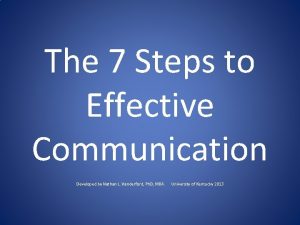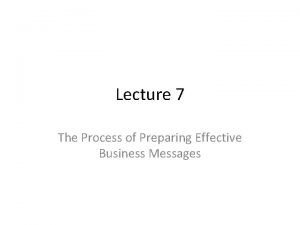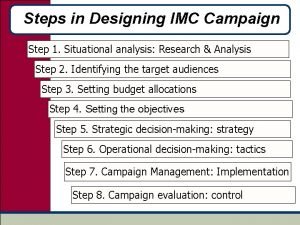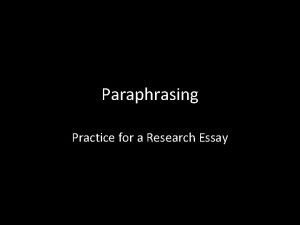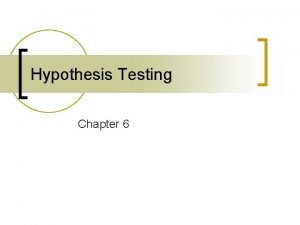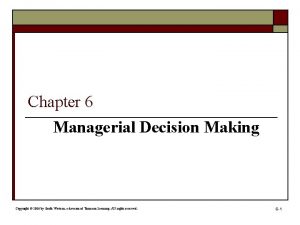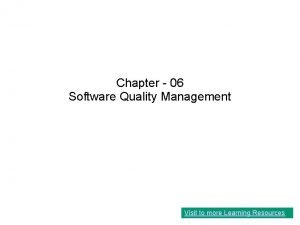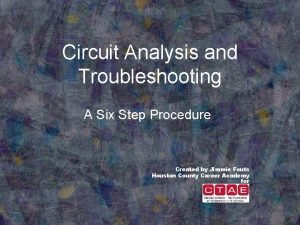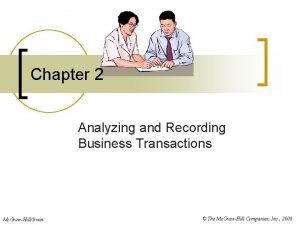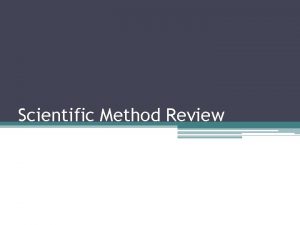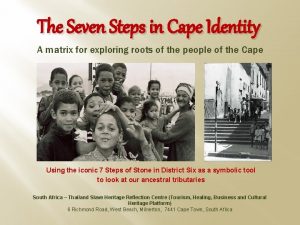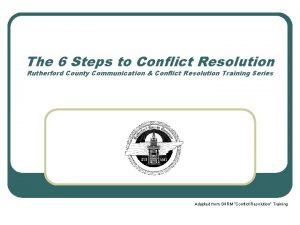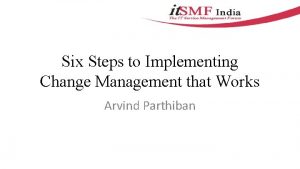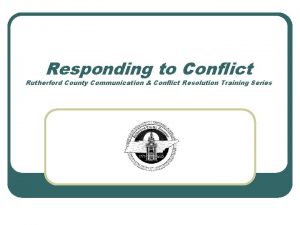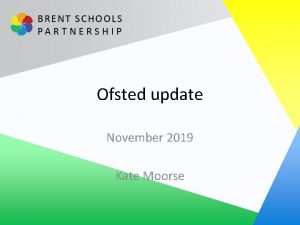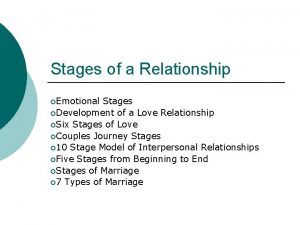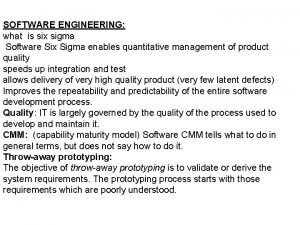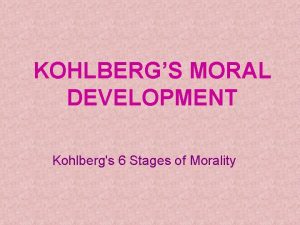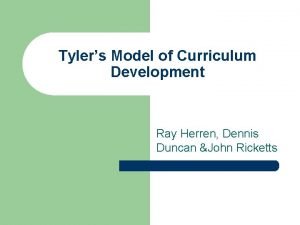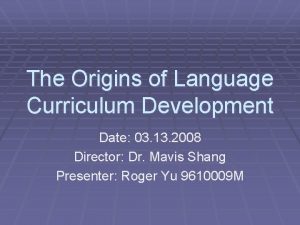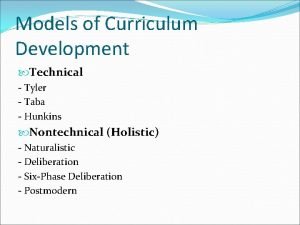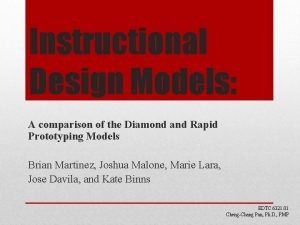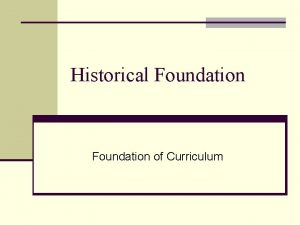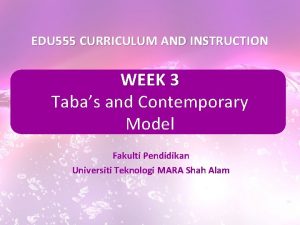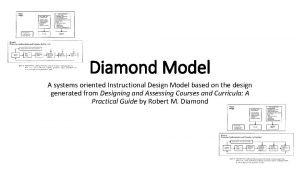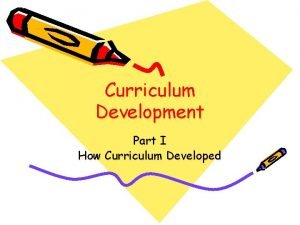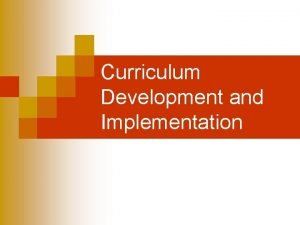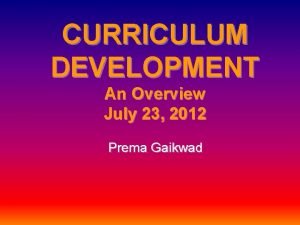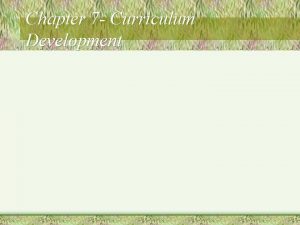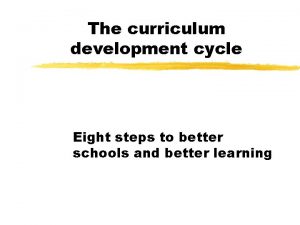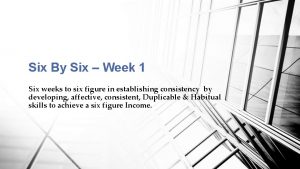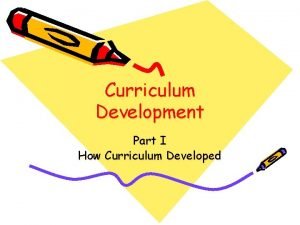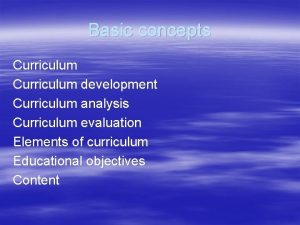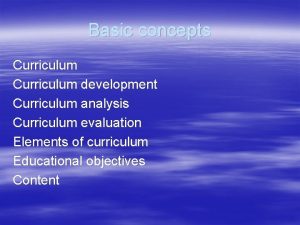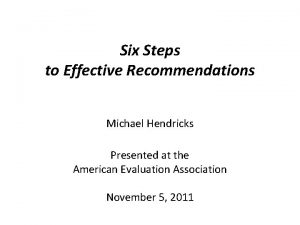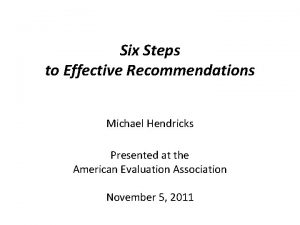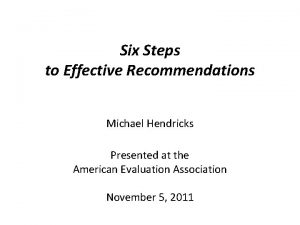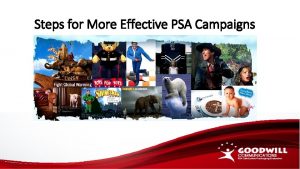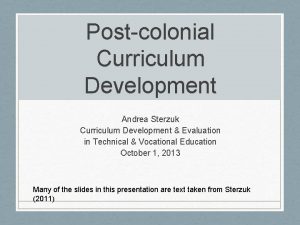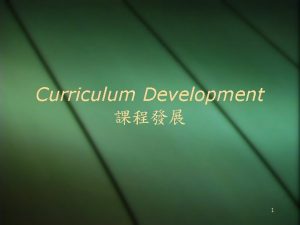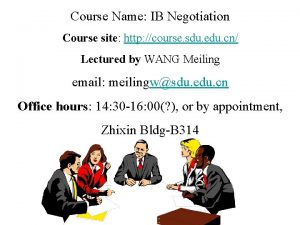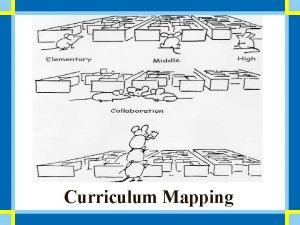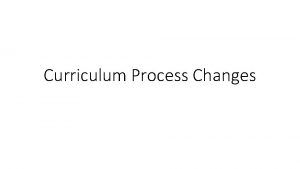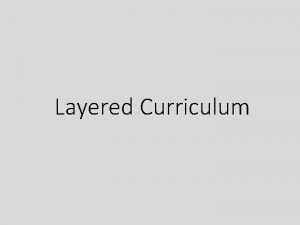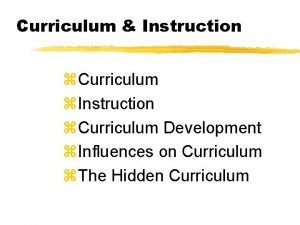Six Steps to Effective Course Curriculum Development http














































- Slides: 46

Six Steps to Effective Course & Curriculum Development http: //tinyurl. com/Curriculum. Development Madhavi Dandu, MD, MPH Derek Harmon, Ph. D March 23, 2020

A curricular consultation… • You are curricular dean for a day • A colleague comes to you raving about the work that Tulane is doing with culinary medicine* • Your colleague is convinced that we must adopt a curriculum addressing it here • Jot down on sticky notes your next steps and/or approaches (one idea per post-it) *Using nutrition/cooking to restore/maintain health. https: //www. acpm. org/page/culinarymedicine & https: //www. huffpost. com/entry/culinary-medicine-food_n_5 b 4 df 601 e 4 b 0 fd 5 c 73 bf 31 f 0

Objectives By the end of this session: • Describe Kern’s 6 -step process for curriculum development • Discuss the importance of conducting a needs assessment in curriculum development • Write SMART-er learning objectives • Discuss the importance of matching objectives to learning strategies

Outline • Presentation • Small Group Activity #1 -BREAK • Presentation • Small Group Activity #2 • Presentation • Small Group Activity #3 • Presentation • Wrap-up and Evaluations

The Kern Model 1. Problem Identification & General Needs Assessment What is the health care problem that needs to be solved? What are the current vs. ideal approaches? 6. Evaluation & Feedback Did it work? 5. Implementation What resources are necessary to deliver this curriculum? 2. Needs Assessment of Targeted Learners What do your students need? What does your community partner need? 3. Goals and Specific Measurable Objectives What are the goals and specific, measurable objectives? 4. Educational Strategies What teaching and assessment methods are best suited to your objectives? Kern et al, 1998

Construct a curriculum that will… help combat childhood obesity

1. Problem ID and General Needs Assessment Questions to ask • What is the health care/societal problem that needs to be solved? • Example: Childhood obesity

1. Problem ID and General Needs Assessment Questions to ask WHAT WHOM does the problem affect? • • Clinical outcomes Quality of life Quality of health care Use of health care & other resources Costs Patient & provider satisfaction Work/productivity Societal function does the problem affect? • • Patients Health care professionals Educators Society What is the qualitative and quantitative importance of these effects?

1. Problem ID and General Needs Assessment Questions to ask Approaches to address problem: CURRENT Patients -Diets, exercise, pills, gadgets Health Care Professionals -Recommend: diet and exercise Educators -Science -Teaching Society -Biggest Loser -Fad diets -Beauty standards IDEAL -Education for prevention - More opportunities for biking and recreation

1. Problem ID and General Needs Assessment Where to get the info? Review Available Literature Published literature, clinical practice guidelines, accreditation bodies, professional societies, governmental data and reports Consultants /Experts Interviews Collect New Information Hospital records

Overview of the Six Steps 1. Problem Identification & General Needs Assessment What is the problem that needs to be solved? What are the current vs. ideal approaches? 6. Evaluation & Feedback Did it work? 5. Implementation What resources are necessary to deliver this curriculum? 2. Needs Assessment of Targeted Learners What do your students need? What does your school need? 3. Goals and Specific Measurable Objectives What are the specific, measurable goals and aims? 4. Educational Strategies What teaching and assessment methods are best suited to your objectives? Kern et al, 1998

2. Targeted Needs Assessment Environment Targeted Learners

2. Targeted Needs Assessment Questions to ask Previous Training & Experiences Planned Training & Experiences Existing KSA Current Performance / Behaviors Learning Needs

2. Targeted Needs Assessment Questions to ask Existing Curriculum Barriers Politics & Policies Enabling/ Reinforcing Factors Stakeholders Resources Space Hidden/ Informal Curriculum Tech Support

2. Targeted Needs Assessment Questions to ask • Are data sources already available? • How many resources should be devoted to this process? • What are long term plans for using the information that is gathered?

2. Targeted Needs Assessment Methods for collecting information • • Inventory of existing training Informal discussion Formal interviews Focus groups Questionnaires Observation Tests/exams

Don’t trust us…

CURRICULUM DEVELOPMENT ONLINE WORKSHEET Groups of 3 -4 people Small Group: Complete steps 1 & 2 (10 mins) Report back to Large Group (10 -15 mins)

Break! 10 Minutes

Overview of the Six Steps 1. Problem Identification & General Needs Assessment What is the problem that needs to be solved? What are the current vs. ideal approaches? 6. Evaluation & Feedback Did it work? 5. Implementation What resources are necessary to deliver this curriculum? 2. Needs Assessment of Targeted Learners What do your students need? What does your school need? 3. Goals and Specific Measurable Objectives What are the specific, measurable goals and aims? 4. Educational Strategies What teaching and assessment methods are best suited to your objectives? Kern et al, 1998

Goal https: //cooking. nytimes. com/recipes/1019081 -baked-alaska https: //cooking. nytimes. com/recipes/1015853 -cheese-souffle

Objectives https: //en. wikipedia. org/wiki/Whipped_cream http: //freefoodphotos. com/imagelibrary/dairy/slides/cheese_grated. html

3. Goals and Objectives Definitions • Goals: broad, general purpose toward which an effort is directed – Longer term – Achieved by fulfilling related objectives • “To understand the endocrine system”

3. Goals and Objectives Definitions • Learner Objectives – Shorter term / building blocks – Represent the perspective of the learner • “List the three layers of the adrenal cortex” • “Identify the hormones produced by each layer of the adrenal cortex”

3. Goals and Objectives Why do we need objectives? • Provide a target for instruction – Help novice learners prioritize concepts – Make the links between sessions-courses-curricula more explicit • Guide instructors – Selecting instructional methods and strategies – Developing sound assessments • Required by accrediting bodies

3. Goals and Objectives How to Write Good Objectives • Make them SMART • Who will do (how much) of What (how well) by When Doran, Miller, Cunningham; 1981

3. Goals and Objectives Tips for Writing Good Objectives • Choose the right type and domain • Cognitive: getting the knowledge • Affective: having the attitude • Psychomotor: gaining the skill

3. Goals and Objectives

3. Goals and Objectives

Common errors in learning objectives • Written from the standpoint of content to be covered – “Learn the thyroid, parathyroid, adrenal, etc. ” • Verbs used are not measurable/observable – “Understand therapies used for infectious diseases” – “Learn the thyroid, parathyroid, adrenal, etc. ” • Verbs used do not reflect the level to which learner will be assessed or should be expected to perform – “List the factors influencing dialysability of drugs” – “Draw structures of the thyroid hormones”

How can we make these SMARTer? 1. Understand the role of flossing teeth in reducing gum disease. 2. Grasp the objectives and deliverables for the course 3. Identify typical statistical techniques used in economic research. 4. Describe some of the mechanisms through which interprofessional teamwork helps prepare students in health professions for future work with underserved populations.

CURRICULUM DEVELOPMENT ONLINE WORKSHEET Work in your groups to review your assigned proposal and complete step 3 (10 mins) Report back to Large Group (10 mins)

Overview of the Six Steps 1. Problem Identification & General Needs Assessment What is the problem that needs to be solved? What are the current vs. ideal approaches? 6. Evaluation & Feedback Did it work? 2. Needs Assessment of Targeted Learners What do your students need? What does your school need? 5. Implementation What resources are necessary to deliver this curriculum? 3. Goals and Specific Measurable Objectives What are the specific, measurable goals and 4. Educational Strategies & Assessments aims? What teaching and assessment methods are best suited to your objectives? Kern et al, 1998

4. Educational Strategies & Assessments • Identify instructional methods that are consistent with learning objectives • Use multiple methods whenever possible • Identify assessment methods consistent with learning objectives and teaching methods • Choose methods and assessments that are feasible for the resources available

Examples of Teaching Strategies Traditional • Lectures • Small groups • Standardized patients • Observed patient encounter • Team-based learning Contemporary • Storytelling • Role playing • Scenario-based learning • Video

Dale’s Cone of Experience Adapted from E. Dale, Audiovisual Methods in Teaching, 1969, NY: Dryden Press.

“Tell me and I forget; teach me and I may remember; involve me and I will learn” -Xun Zi, Confucian philosopher, revised translation

4. Educational Strategies & Assessments Examples Learning Objective Educational Strategy Assessment Knowledge (Cognitive) When given the results of an MMSE, identify scores suggestive of mild, moderate, and severe dementia Web-based module Quiz Attitudes (Affective) Describe the potential effects of undiagnosed dementia on the patient and the family Group discussion Reflection in with electronic poll portfolio Skills (Psychomotor) Develop a shared plan for management SP or clinical of dementia symptoms with a patient or exposure patient advocate OSCE

CURRICULUM DEVELOPMENT ONLINE WORKSHEET Work in your groups to review your assigned proposal and complete step 4 (10 mins)

Overview of the Six Steps 1. Problem Identification & General Needs Assessment What is the problem that needs to be solved? What are the current vs. ideal approaches? 6. Evaluation & Feedback Did it work? 2. Needs Assessment of Targeted Learners What do your students need? What does your school need? 5. Implementation What resources are necessary to deliver this curriculum? 3. Goals and Specific Measurable Objectives What are the specific, measurable goals and aims? 4. Educational Strategies What teaching and assessment methods are best suited to your objectives? Kern et al, 1998

5. Implementation Checklist q Identify resources (monetary, physical, human) q Obtain support – internal, external q Develop administrative mechanisms to support the curriculum q Anticipate and address barriers • Manage expectations q Plan to introduce curriculum • Pilot, phase-in, full implementation q Budget time for reflection

Overview of the Six Steps 1. Problem Identification & General Needs Assessment What is the problem that needs to be solved? What are the current vs. ideal approaches? 6. Evaluation & Feedback Did it work? 5. Implementation What resources are necessary to deliver this curriculum? 2. Needs Assessment of Targeted Learners What do your students need? What does your school need? 3. Goals and Specific Measurable Objectives What are the specific, measurable goals and aims? 4. Educational Strategies What teaching and assessment methods are best suited to your objectives? Kern et al, 1998

Kirkpatrick Model of Training Evaluation • Step 1: Reaction – How well did the learners like the learning process? • Step 2: Learning – What did they learn? • Step 3: Behavior – What changes in performance resulted from the learning process? • Step 4: Results – What are the tangible results of the learning process in terms of reduced cost, improved quality, increased production, efficiency, etc. Kirkpatrick D. Evaluating Training Programs, 1994

Satisfaction = good, but only one measure Learner feedback is not particularly valuable for Appropriateness of content Instructor’s knowledge of subject matter Degree to which material reflects current information Appropriateness of the assessment standard Learner feedback is especially valuable for Amount of time spent on a particular concept relative to its importance to the curriculum objectives Types of exercises used to promote matters of a concept Characteristics of the classroom dynamic or learning environment Potential links to other concepts

Summary of the Six Steps 1. Problem Identification & General Needs Assessment 2. Needs Assessment of Targeted Learners 6. Evaluation & Feedback 5. Implementation 3. Goals and Objectives 4. Educational Strategies Kern et al, 1998

Creative Commons License Attribution-Non. Commercial-Share Alike 3. 0 Unported You are free: • to Share — to copy, distribute and transmit the work • to Remix — to adapt the work Under the following conditions: • Attribution. You must give the original authors credit (but not in any way that suggests that they endorse you or your use of the work). • Noncommercial. You may not use this work for commercial purposes. • Share Alike. If you alter, transform, or build upon this work, you may distribute the resulting work only under a license identical to this one. See http: //creativecommons. org/licenses/by-nc-sa/3. 0/ for full license.
 Different stages involved in portfolio management
Different stages involved in portfolio management Six steps for effective feedback
Six steps for effective feedback Six traits of effective writing
Six traits of effective writing 7 steps to effective communication
7 steps to effective communication Preparing effective business message
Preparing effective business message Steps in developing effective communications
Steps in developing effective communications Rabostic
Rabostic 6 steps to effective paraphrasing
6 steps to effective paraphrasing Classify each polygon
Classify each polygon Header bond t junction
Header bond t junction Course title and course number
Course title and course number Course interne course externe
Course interne course externe Six steps of hypothesis testing
Six steps of hypothesis testing Netflix perceptual map
Netflix perceptual map 6 step decision making process
6 step decision making process Six sigma methodology defines three core steps
Six sigma methodology defines three core steps The distribution objective must be congruent with
The distribution objective must be congruent with 6 troubleshooting steps
6 troubleshooting steps Six steps of business transaction analysis
Six steps of business transaction analysis Six steps to the scientific method
Six steps to the scientific method Seven steps of stone
Seven steps of stone 6 steps to resolve conflict
6 steps to resolve conflict Implement change management with these six steps
Implement change management with these six steps 6 steps to conflict resolution
6 steps to conflict resolution Http //mbs.meb.gov.tr/ http //www.alantercihleri.com
Http //mbs.meb.gov.tr/ http //www.alantercihleri.com Siat.ung.ac.id krs
Siat.ung.ac.id krs Ofsted mythbuster
Ofsted mythbuster Curriculum as a content
Curriculum as a content Franksbridge primary school
Franksbridge primary school Types of axial movement
Types of axial movement 5 stages of relationships susan campbell
5 stages of relationships susan campbell 6 sigma software
6 sigma software What are the 6 stages of moral development?
What are the 6 stages of moral development? Leader safety course module 2 answers
Leader safety course module 2 answers Tyler’s model
Tyler’s model Selection and gradation
Selection and gradation Hunkins model of curriculum development
Hunkins model of curriculum development Diamond model of curriculum development
Diamond model of curriculum development Historical foundation of curriculum development
Historical foundation of curriculum development Taba's model of curriculum development
Taba's model of curriculum development System oriented design
System oriented design Curriculum wing in pakistan
Curriculum wing in pakistan Example of taba model
Example of taba model Phases of curriculum development
Phases of curriculum development Curriculum development process
Curriculum development process Curriculum development models
Curriculum development models Curriculum development cycle
Curriculum development cycle



